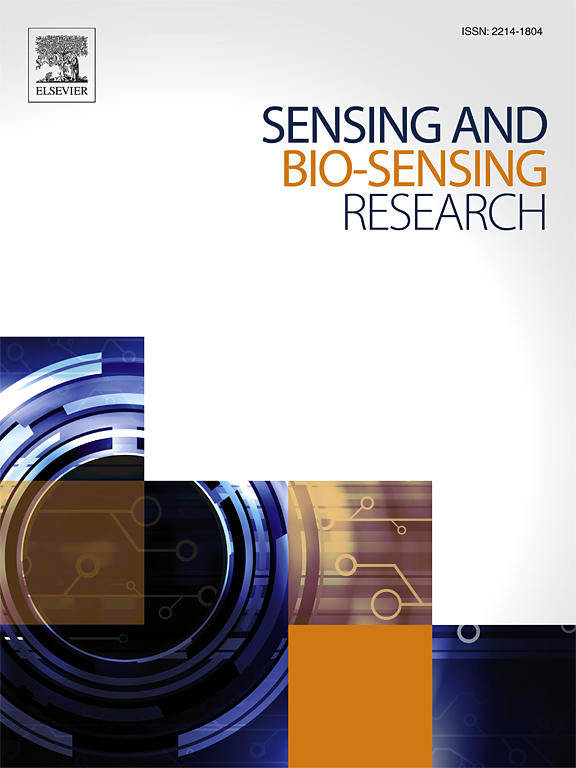Ternary metal oxide of CuNiCo2O4nanorods (1D) distributed on g-C3N4 (2D) nanocomposite for non-enzymatic glucose sensing application
IF 5.4
Q1 CHEMISTRY, ANALYTICAL
引用次数: 0
Abstract
Non-enzymatic glucose sensing has a major demand in research community for developing a good glucose sensor. Because enzyme based glucose sensor has several disadvantages such as high cost, difficult fabrication process and instability. To overcome these disadvantages, transition metal oxides (TMO) with g-C3N4 nanocomposite are a good choice for non-enzymatic medium for developing a good glucose sensor. Transition metal oxide has multiple oxidation state, different morphology, high conductivity, enhanced catalytic activity and 2D graphitic carbon nitride has a higher stability. In this work, our particular interest in ternary metal oxide (CuNiCo2O4) nanorods (1D) distributed on surface of the g-C3N4 (2D) nanocomposite were prepared by simple hydrothermal method. The prepared nanocomposite was performed a basic studies such as XRD, FESEM, HRTEM, FTIR, XPS and an electrochemical studies using nickel foam as a current collector. Chronoampermetry analysis produced a sensitivity of 4368 μA Cm−2 mM−1 and low detection limit (LOD) 1.91 μM. The produced response time is 4 s. The measured results of the CuNiCo2O4nanorods (1D) on the surface of g-C3N4 (2D) nanocomposite could be a satisfied material for non-enzymatic glucose sensor.
分布在g-C3N4 (2D)纳米复合材料上的cunico2o4纳米棒(1D)三元金属氧化物用于非酶促葡萄糖传感
非酶葡萄糖传感是目前研究领域对开发一种好的葡萄糖传感器的主要需求。由于酶基葡萄糖传感器存在成本高、制作工艺困难和不稳定等缺点。为了克服这些缺点,过渡金属氧化物(TMO)与g-C3N4纳米复合材料是开发良好的葡萄糖传感器的非酶介质的一个很好的选择。过渡金属氧化物具有多种氧化态、不同形态、高导电性、增强的催化活性和二维石墨氮化碳具有较高的稳定性。在这项工作中,我们特别感兴趣的是用简单的水热法制备了分布在g-C3N4 (2D)纳米复合材料表面的三元金属氧化物(CuNiCo2O4)纳米棒(1D)。以泡沫镍为集流剂,对所制备的纳米复合材料进行了XRD、FESEM、HRTEM、FTIR、XPS等基础研究和电化学研究。时间电流分析法灵敏度为4368 μA Cm−2 mM−1,低检出限(LOD)为1.91 μM。生成的响应时间为4秒。在g-C3N4 (2D)纳米复合材料表面制备的cunico2o4纳米棒(1D)可以作为无酶葡萄糖传感器的理想材料。
本文章由计算机程序翻译,如有差异,请以英文原文为准。
求助全文
约1分钟内获得全文
求助全文
来源期刊

Sensing and Bio-Sensing Research
Engineering-Electrical and Electronic Engineering
CiteScore
10.70
自引率
3.80%
发文量
68
审稿时长
87 days
期刊介绍:
Sensing and Bio-Sensing Research is an open access journal dedicated to the research, design, development, and application of bio-sensing and sensing technologies. The editors will accept research papers, reviews, field trials, and validation studies that are of significant relevance. These submissions should describe new concepts, enhance understanding of the field, or offer insights into the practical application, manufacturing, and commercialization of bio-sensing and sensing technologies.
The journal covers a wide range of topics, including sensing principles and mechanisms, new materials development for transducers and recognition components, fabrication technology, and various types of sensors such as optical, electrochemical, mass-sensitive, gas, biosensors, and more. It also includes environmental, process control, and biomedical applications, signal processing, chemometrics, optoelectronic, mechanical, thermal, and magnetic sensors, as well as interface electronics. Additionally, it covers sensor systems and applications, µTAS (Micro Total Analysis Systems), development of solid-state devices for transducing physical signals, and analytical devices incorporating biological materials.
 求助内容:
求助内容: 应助结果提醒方式:
应助结果提醒方式:


